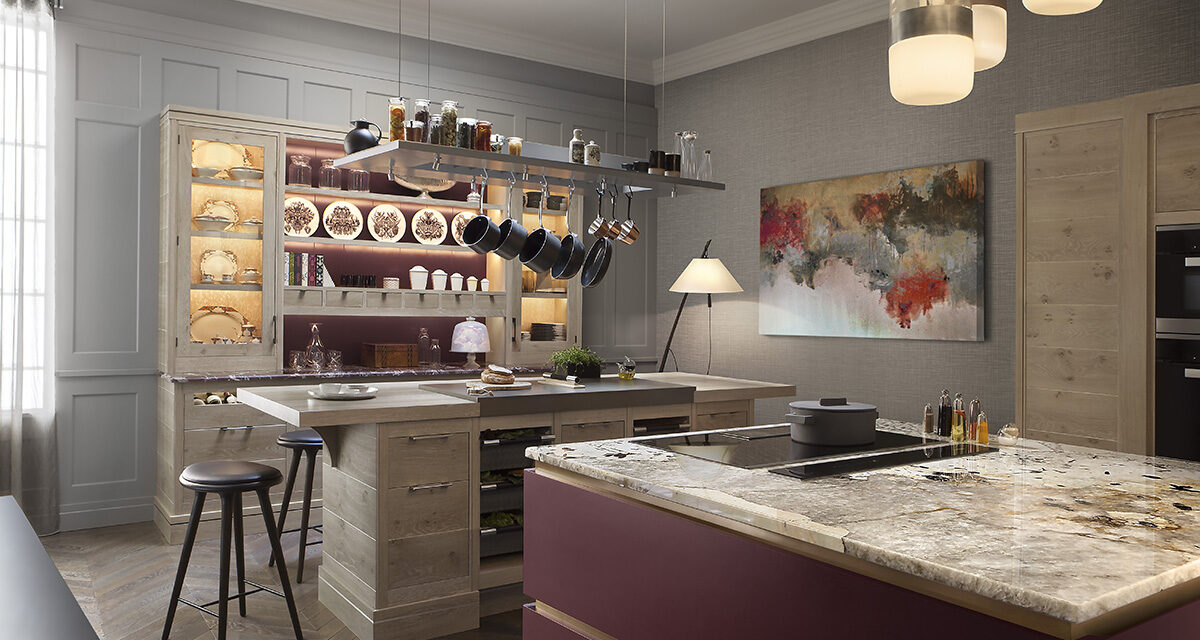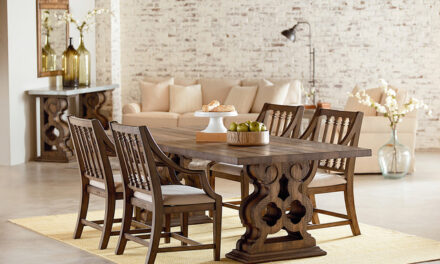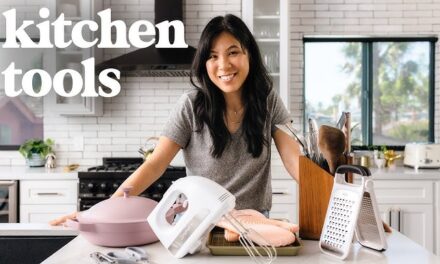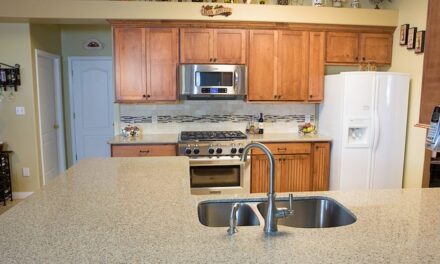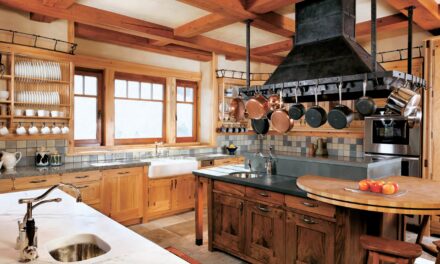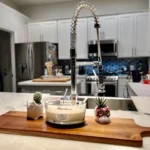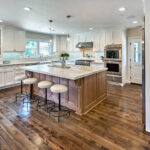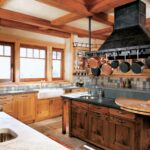A home baking kitchen is more than just a functional space—it’s a sanctuary where creativity meets tradition, and the comforting aroma of freshly baked goods fills the air. Whether you’re a professional pastry chef or a passionate hobbyist, having a dedicated baking area in your home can elevate your culinary experience to new heights. Imagine walking into a warm, well-organized kitchen where every tool, from mixers to rolling pins, is within reach, and your countertops are free to roll out doughs or whip up meringues with ease.
The essence of a baking kitchen lies in its ability to blend practicality with a warm, inviting atmosphere. Specialized features such as double ovens, spacious countertops, and smart storage for baking essentials allow for both efficiency and creativity. The right layout, combined with thoughtful touches like an island with seating or open shelving showcasing beautiful bakeware, can transform your kitchen into a cozy, inspiring space where friends and family gather to enjoy the fruits of your labor.
Whether you’re experimenting with new recipes or perfecting a family favorite, a well-designed baking kitchen becomes the heart of the home, where sweet memories and delectable treats are made every day.
Flour Power: Designing a Dream home Baking Kitchen
In this guide, we’ll take you step by step through everything you need to consider when designing your perfect baking kitchen. From layout and storage to appliances and aesthetics, let’s explore how you can turn your kitchen into the ultimate baking haven.For more information visit here
Table of Contents
Choosing the Right Layout for a Home Baking Kitchen
Designing an efficient and comfortable layout is the foundation of your dream baking kitchen. Unlike standard kitchen setups, a home baking kitchen requires unique considerations to accommodate the specific tools, appliances, and workflow that baking demands.
A. Work Triangle vs. Work Zones
In a traditional kitchen, the work triangle—connecting the sink, stove, and refrigerator—is an essential design principle. For home baking kitchen, the concept of work zones is more appropriate. This method focuses on creating dedicated areas for specific tasks: mixing, rolling, prepping, and cleaning.
- Mixing and Prep Zone: Ensure you have ample counter space close to the oven and sink, where ingredients can be easily accessed. Having a central island or a dedicated prep station is ideal for rolling out dough, kneading bread, or decorating cakes. If possible, situate this area near your pantry or dry storage.
- Baking Zone: Your baking zone should be centered around your oven(s) and should include space for trays, cooling racks, and an area to place finished goods directly from the oven. Ideally, this zone should be adjacent to the prep area, minimizing the need to move hot items across the kitchen.
- Cleaning Zone: Though it’s not the star of the show, a functional cleaning zone is essential to your workflow. A deep sink for washing larger mixing bowls and sheet pans is a must. Dishwashers with flexible interior space can also make clean-up more efficient.
B. Open vs. Closed Layouts
Deciding between an open or closed layout depends on your lifestyle and needs.
- Open Layout: An open-plan home baking kitchen allows you to socialize with family or guests while baking. It integrates the kitchen with the living or dining area and makes the space feel larger. This is ideal if you like to bake while keeping an eye on the kids or entertaining friends.
- Closed Layout: For those who prefer a more private, focused baking space, a closed home baking kitchen offers separation from the rest of the house. This type of layout can help keep noise and mess contained, allowing for more concentration.
Selecting Appliances for a Baking Kitchen
Appliances are the heart of any kitchen, but for a baking-centric space, specialized equipment can make all the difference. Here are the key appliances that every home baking kitchen should have.
A. Ovens
One of the most important decisions you’ll make is choosing the right oven(s). A regular oven might suffice for occasional bakers, but avid bakers benefit from the following:
- Double Ovens: Double ovens give you the flexibility to bake multiple items at different temperatures simultaneously. One oven could be baking a cake while the other is roasting a batch of cookies.
- Convection Ovens: Convection ovens are great for even heat distribution, ensuring that pastries rise evenly and bake more quickly.
- Steam Ovens: Steam ovens inject moisture into the baking process, perfect for bread home baking kitchen, as the steam creates a crisp crust while keeping the inside soft.
B. Stand Mixer
A high-quality stand mixer is a baker’s best friend. From kneading dough to whipping cream, it’s a time-saving essential. Consider creating a dedicated space on your counter for the stand mixer, or have a pull-out shelf designed to store and easily access this vital appliance.
C. Refrigeration
Proper refrigeration is key for storing ingredients like butter, eggs, and cream. You’ll need plenty of room for chilled doughs and pastries, so consider a French-door refrigerator with wide shelves. If you have space, a separate fridge or freezer drawer dedicated to baking ingredients and finished treats can be a luxury worth adding.
D. Warming Drawers
A warming drawer can be a great addition, especially for bakers who like to proof doughs at controlled temperatures. It can also be used to keep dishes warm before serving.
Essential Storage Solutions for Bakers
Organized storage is crucial in a home baking kitchen where multiple small tools and ingredients are frequently used. Custom storage solutions can help keep everything in order and accessible.
A. Dry Storage for Ingredients
Flour, sugar, baking soda, and other dry ingredients should be easily accessible and stored in airtight containers to keep them fresh. A pull-out pantry or dedicated shelving with labeled jars can help with both organization and ease of use.
- Tip: Arrange ingredients by frequency of use. Everyday items should be at eye level, while specialty ingredients can be placed on higher shelves.
B. Specialized Tool Storage
From cookie cutters to cake pans, home baking kitchen have a variety of small and large tools that need a home. Consider the following storage options:
- Drawer Dividers: Custom drawer inserts can neatly organize tools like measuring cups, spatulas, and rolling pins.
- Vertical Tray Storage: Install vertical dividers in cabinets to easily store sheet pans, cutting boards, and cooling racks without stacking them.
- Lazy Susans: Perfect for deep cabinets, lazy Susans allow for easy access to all your home baking kitchen spices, extracts, and small baking essentials.
C. Appliance Garages
Many bakers accumulate a wide range of appliances: food processors, hand mixers, and blenders. An appliance garage is a hidden storage solution that keeps these small appliances accessible without cluttering the countertops.
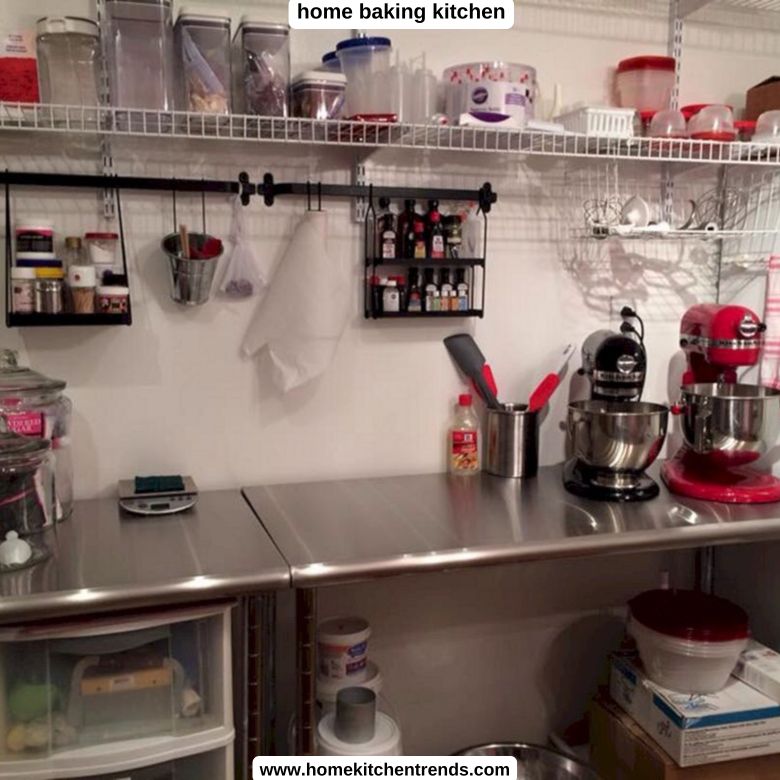
Countertop and Surface Selection
A home baking kitchen requires durable, spacious countertops that can handle the wear and tear of rolling dough and other prep work. The right surface material is critical to ensure easy cleanup, durability, and functionality.
A. Marble
Marble is a classic choice for bakers because of its naturally cool surface, which is perfect for rolling dough, especially for pastries. However, it’s prone to staining and scratching, so be prepared for extra care.
B. Quartz
Quartz is a great alternative to marble, offering the same smooth, cool surface but with greater durability and resistance to stains. It’s a non-porous surface, making it easier to clean, which is ideal when dealing with sticky doughs or chocolate.
C. Butcher Block
Butcher block countertops give your home baking kitchen a warm, rustic feel and can be an excellent surface for kneading dough. Regular maintenance, such as oiling, is necessary to prevent water damage, but its aesthetic appeal makes it worth the effort for many bakers.
Lighting for Function and Ambience
The right lighting is essential for both functionality and ambience in a home baking kitchen. Good lighting ensures you can see what you’re doing during intricate tasks like decorating cakes or measuring ingredients, while also creating a welcoming atmosphere.
A. Task Lighting
Task lighting focuses on specific work areas. Under-cabinet lights are perfect for illuminating countertops where you’ll be rolling dough or mixing batters. Pendant lights over an island can also serve as both task and accent lighting.
B. Ambient Lighting
Ambient lighting creates an overall warm glow in the home baking kitchen, making it a pleasant place to spend time. Recessed lighting in the ceiling can brighten the entire space, while dimmable fixtures allow you to adjust the mood as needed.
C. Accent Lighting
Consider installing accent lighting inside glass-front cabinets to highlight your beautiful bakeware or to showcase a special collection of vintage rolling pins.
Ergonomics and Comfort in a Baking Kitchen
Baking often requires long periods of standing and repetitive motions, so designing with ergonomics in mind can make the experience much more comfortable and enjoyable.
A. Counter Height
Standard counter height is usually fine for most baking tasks, but if you do a lot of rolling or kneading, you might want a lower surface to reduce strain on your arms and shoulders. Consider a multi-height island where one part is lower specifically for dough work.
B. Seating
Adding seating to your home baking kitchen can provide a comfortable spot to rest between batches. A cushioned stool at the island is a great option, allowing you to sit while decorating cakes or kneading dough.
C. Anti-Fatigue Mats
If you spend hours at a time in the home baking kitchen, standing on hard floors can be tiring. Anti-fatigue mats placed in front of your prep area or sink can reduce strain on your feet, legs, and back.
Personal Touches and Design Aesthetics
Finally, your home baking kitchen should be a reflection of your personal style. Incorporating design elements that make you feel happy and inspired will transform the space into a true baking paradise.
A. Color Schemes
Bright, cheerful colors can energize your space, while softer, neutral tones can create a calm, relaxing environment. Popular color schemes for baking kitchens include whites with pops of pastel colors, or rich, warm hues paired with natural wood finishes.
B. Displaying Bakeware
Beautiful bakeware deserves to be seen! Consider incorporating open shelving or glass-front cabinets to display your favorite mixing bowls, cake stands, or cookie jars. These items double as decor, adding both function and personality to your home baking kitchen.
C. Chalkboards and Message Centers
A chalkboard wall or message center can serve as a fun, functional way to jot down recipes, shopping lists, or reminders. It adds a touch of whimsy and practicality to the space.
The Importance of Temperature Control
Many baked goods are highly sensitive to temperature, both in the oven and the kitchen itself. To bake perfectly every time, it’s essential to maintain a consistent temperature in your baking environment.
A. Cooling and Humidity Control
Humidity levels in your home baking kitchen can affect the results of your baking. For instance, too much humidity can make meringues fail to stiffen, while dry air can cause bread dough to dry out. Installing a dehumidifier or a humidifier, depending on your local climate, can help maintain ideal conditions for baking. Ensure your kitchen has a thermometer and humidity gauge to monitor conditions effectively.
B. Proper Cooling Space
After baking, having a dedicated cooling area is important. Cooling racks should be placed in an easily accessible spot with enough airflow around them. Ideally, your cooling zone should be far from heat sources like ovens, stoves, or windows with direct sunlight to avoid interfering with the cooling process.
Incorporating Smart Technology into Your Baking Kitchen
With advancements in home baking kitchen technology, it’s easier than ever to bake with precision and convenience. Smart appliances can streamline the baking process and improve results.
A. Smart Ovens
Many modern ovens come equipped with smart technology, allowing you to control and monitor your baking remotely. You can preheat your oven from your phone, receive alerts when your bake is ready, or even access preset baking modes for specific recipes. Some smart ovens also feature built-in cameras so you can watch your pastries rise without opening the door and losing heat.
B. Smart Thermometers
Smart thermometers can be invaluable, especially when working with bread or cakes that require precise internal temperatures. These thermometers send real-time data to your phone or tablet, ensuring you bake to perfection without constant checking.
C. Recipe Apps and Assistants
Incorporating a smart assistant like Amazon Alexa or Google Assistant into your baking kitchen can make it easier to follow recipes, set timers, and convert measurements hands-free. There are also numerous recipe apps that allow you to follow step-by-step baking instructions or scale recipes for larger or smaller batches.
Sustainability in a home baking kitchen
Sustainability is an important consideration for modern kitchens, and a baking kitchen is no exception. There are several ways you can make your space more eco-friendly without sacrificing functionality or style.
A. Energy-Efficient Appliances
Opt for energy-efficient ovens, refrigerators, and dishwashers to reduce your energy consumption. Look for ENERGY STAR-certified appliances that use less electricity and water, which can save you money on utility bills while helping the environment.
B. Sustainable Materials
Choose sustainable materials for countertops, cabinetry, and flooring. Bamboo, recycled glass, and reclaimed wood are eco-friendly options that add warmth and character to your kitchen while being kinder to the environment.
Safety Considerations in a Baking Kitchen
Baking may seem like a safe activity, but there are still safety risks in any home baking kitchen environment. Here are some tips for creating a safe baking space.
A. Fire Safety
Install a smoke detector and fire extinguisher in or near your kitchen. Ensure your oven has a built-in safety feature, like an automatic shut-off or temperature limiters, to prevent overheating.
B. Child Safety
If children are helping out in the home baking kitchen, make sure sharp objects, hot pans, and heavy appliances are stored securely. Consider child-proof locks on drawers and cabinets containing knives or electrical equipment.
Maximizing Small Spaces for a Baking Kitchen
If you’re working with a smaller kitchen, it’s still possible to create an efficient and delightful baking space with a bit of creativity.
A. Compact Appliances
Look for compact versions of essential appliances, like smaller ovens, narrow refrigerators, or pull-out countertop extensions that provide extra prep space when needed.
B. Vertical Storage Solutions
Maximize your vertical space by installing tall cabinets, shelving, or hanging storage systems. Overhead pot racks, magnetic knife strips, and pegboards can help keep counters clear while ensuring your tools are within easy reach.
C. Multipurpose Furniture
Consider multipurpose furniture like a rolling island that can be used for prep, storage, or even seating. When not in use, it can be moved out of the way to free up space.
To sum up
You can change your approach to baking by designing your ideal home baking kitchen, which is a rewarding experience. Creating a space that fulfils your utilitarian demands and stimulates joy and creativity can be achieved with careful planning. Each choice you make helps create a baking kitchen that reflects your own style and fuels your enthusiasm, from designing the ideal layout to picking the best materials, appliances, and smart technology.
Your baking kitchen will grow to be the centre of your house, whether you’re baking for your family, opening a home bakery, or just need a place to try out new recipes. You can produce delectable sweets, treasured memories, and infinite moments of culinary magic for years to come with a well-designed environment customised to your workflow and tastes.

